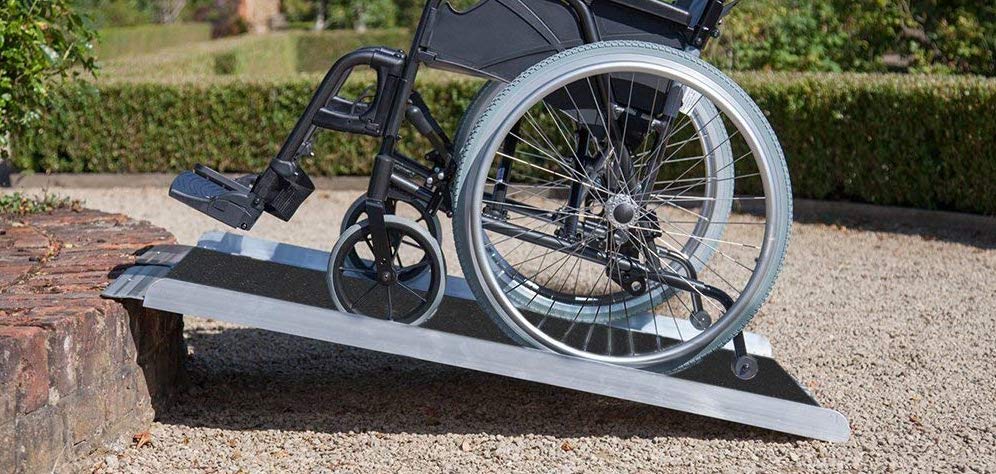Are you struggling to find an affordable and reliable way to create access for wheelchair users in your home or business? With the help of portable wheelchair ramps, you can easily overcome all obstacles and make sure that everyone has the same opportunities for access.
Read this guide to learn how these ramps work and why they are so important for accessibility.

When it comes to accessible design, wheelchair ramps are an important part of creating user-friendly buildings and homes for people with physical impairments or mobility challenges. Ramps provide safe, convenient access for wheelchairs and scooters, making it easier to move around or between levels in a building. However, not all ramps are the same—and in some circumstances, traditional ramps may be impractical.
Portable wheelchair ramps allow the user to easily reposition the ramp according to specific needs, offering greater flexibility in terms of space requirements and access options. By their nature they are easy to install and can be easily moved from one site to another, making them ideal for temporary use at events or buildings which don’t require permanent access solutions. Therefore they are an important accessibility aid that should be considered when you’re looking at ways to improve a building’s accessibility.
In this guide we will explore the many advantages of portable wheelchair ramps—from practical considerations such as weight and portability to safety features such as slip-resistant surfaces and built-in security devices—so you can decide if this type of ramp is best suited for your needs.
Explanation of the importance of accessibility
Accessibility is a major concern for those who use wheelchairs or other mobility aids on a regular basis. As the world continues to become increasingly mobile, it is essential that individuals with disabilities have access to facilities, services, and other destinations in order to keep up with their peers. Portable wheelchair ramps provide a much-needed solution for improving accessibility and providing more options for people with limited mobility.
Accessible routes provide individuals with disabilities the same level of access as their non-disabled counterparts when navigating their environment. Portable wheelchair ramps are capable of providing users improved access and mobility when transitioning from one space to another, as well as greater independence when entering new locations. By creating safe and efficient pathways for individuals who wouldn’t normally be able to navigate certain obstacles or spaces, these ramps can reduce stress levels of entering a new place while making sure everyone has the opportunity to participate in daily activities regardless of the challenges they face.
In addition, portable wheelchair ramps offer transportability and flexibility in comparison to permanently installed counterparts. Portable ramps can be used in multiple locations such as public places like schools or shopping centers; they can also be easily moved from one location to another if needed. This provides users with more freedom and versatility while navigating their environment that they may not necessarily have been afforded prior such as avoiding steps or accessing harder-to-reach areas where traditional ramps are absent or not suitable. In addition, portability allows users the opportunity expand into previously inaccessible areas without causing damage which could otherwise lead them into dangerous situations due to lack of space available for safe passage (e.g., paths taken through rough terrain).
Definition of portable wheelchair ramps
A portable wheelchair ramp is defined as a type of ramp that can be easily set up and moved. Portable ramps provide access to anyone with a wheelchair, mobility scooter, or other wheelchair device. When portable ramps are installed in public spaces such as schools, hospitals, and businesses it allows for easier access for people who do not have full mobility.
Portable ramps can provide safe and secure access for wheelchairs by making it easier to enter and exit the building or area. Portable wheelchairs are also able to adapt to different configurations depending on their use. For instance, some portable wheelchair ramps can include adjustable handrails, guard rails, side panels and more. Additionally, many ramps come with optional features such as foldable platform arms which make them even more versatile for different types of terrain when navigating different spaces.
Factors to Consider Before Buying Portable Wheelchair Ramps
When purchasing any wheelchair ramp, there are several factors to consider before making your decision. The following section will outline some of the most important things to look for when selecting a portable wheelchair ramp.
- Size: To ensure maximum accessibility without compromising on safety, purchasing a ramp that is the correct size for your intended use is critical. Measurements such as the width, length, platform gap and height should all be taken into account to determine the best fit for your needs.
- Weight Capacity: Depending on the individual user’s needs and weight limit, different models of ramps and components can handle different amounts of weight. Be sure to select a design that meets and exceeds any user’s weight capacity requirements in order to guarantee safe usage of the product.
- Slope: Portable ramps come with adjustable slopes and those slope measurements should always be taken into consideration when selecting appropriately sized ramps for installation or travel purposes. A general rule of thumb is that it is better to err on the side of caution when selecting a product than assume one size fits all solutions exist in all scenarios.
- Mobility: Due to their portability, many portable wheelchair ramps can be easily folded up or dismantled in order to support travel or relocation needs much more efficiently than traditional ramps on site installations are able to. If mobility is an issue, individuals who require access solutions should always research fully mobile devices in addition when seeking accessible solutions that work best for their lifestyles wherein restriction may occur as a result.
Weight capacity
When selecting a portable wheelchair ramp for your home, office space, or other public facility, it is important to consider the weight capacity of any ramp you are considering. Generally speaking, the maximum weight capacity for portable ramps is 500 lbs or less. This is due to the fact that most portable wheelchair ramps are made with lightweight aluminum and their limited width does not allow for a higher load bearing capacity.
It is also worth noting that scooter users may require additional support in order to ensure a safe and comfortable experience when using any portable ramp. For heavier weight capacities and stringent safety requirements, you should investigate more permanent solutions such as prefabricated or customized modular steel ramps.
Length and width of the ramp
The length and width of the ramp is important in determining the slant angle or grade of the ramp. The length determines how far up or down you need to go and the width determines how gentle or steep a slant will be needed. It is best to consult a professional for guidance on this. In general, for every inch of rise in height, one foot of ramp is necessary. A 30” rise would require at least a 30-foot long ramp with a gentle grade, two feet being optimal. To calculate the proper size for you, measure the total distance from the ground to where your wheelchair needs access and divide that number by two.

It is also important to think about overall portability when considering width and length of your portable wheelchair ramp- wider ramps are heavier and bulkier, making them harder to carry around with you if needed; narrower ramps may not provide enough room for stability when going up or down them as well as enough room for other forms of access such as crutches. Look at both sizes when deciding which type might work best in each situation!
III. Benefits of Portable Wheelchair Ramps
Portable wheelchair ramps help to create safe access for wheelchair-bound persons, enabling them to navigate over a variety of obstacles with ease. The use of such therapeutic devices is critical in order to help individuals overcome physical barriers. Portable wheelchair ramps offer its users the following benefits:
Versatility: Portable ramps are designed to provide easy access into and out of different locations. They can be folded or collapsed and moved conveniently from place to place as needed. Depending on one’s needs, these ramps may come with either a single or double fold feature for added convenience when folding and unfolding the ramp.
Ease of Use: Portable ramps are easy to install, as most products come with instructions that are simple enough for end-users or caregivers to understand and follow easily. Many portable ramp systems also come equipped with a carrying handle, making it convenient and easy to transport the ramp when traveling from one location to another.
Cost-Effective Choice: Compared with more permanent options, portable wheelchair ramps often offer consumers a more cost-effective option. Not only are they less expensive but they also require minimal installation time requiring fewer labor costs than permanent installation solutions. Additionally, since they are portable and can be folded away easily they take up less space which means it is more economical if you decide not to keep them set up at all times or need extra space in your designated area.
Enhanced mobility and independence
Having a portable wheelchair ramp on hand can increase an individual’s safety and provide an enhanced level of convenience in a wide range of settings. Whether used for entering homes, engaging in recreational activities or attending public events, these accessory pieces are designed to make the entire experience easier for wheeled individuals.
A portable wheelchair ramp is designed to bridge any incline gap so wheelchairs can easily roll over it. This design allows wheeled individuals to access areas that would otherwise be inaccessible due to lack of available permanent or stationary ramps. This type of device is ideal both indoors and outdoors as it generally carries weight capacity of up to 600 lbs., making it perfect for providing access even in areas with heavier wheelchairs or scooters. Furthermore, this type of accessory is convenient by nature as they can be easily folded up and carried along with you wherever you go.
By having a portable ramp nearby, those who regularly use wheelchairs are able to come and go with greater ease — leading to more frequent outings and more independent living overall. Together these features make this piece a valuable resource for anyone looking for improved mobility and accessibility in everyday life circumstances.
Improved accessibility
Portable wheelchair ramps can offer an easier and less expensive solution compared to permanent ramps installed on residential or commercial property. Portable wheelchair ramps enable people with physical disabilities to access a variety of locations without going through extensive installation processes. Whether it’s to avoid permanent ramp installation or just needing a solution for a one-time event, portable wheelchair ramps can assist in providing improved accessibility.

Portable wheelchair ramps are designed with versatility in mind, allowing for placement on any type of surface. These products are cost-effective and may easily meet the requirements of handicap accessibility laws and requirements. Depending on the specific need, there are a variety of portable ramp options available from folding suitcase models perfect for home use, to multi-length modular systems used primarily for commercial applications. Additionally, some portable wheelchairs offer features such as handrails and adjustable angle runways that provide users optimal safety when accessing raised elevations indoors or outside. By using these wheelchairs users will be able to maneuver inclines independently while also ensuring proper alignment of their chairs when going up or down slopes. Not only does this provide additional security for those that rely on wheelchairs, but also promotes independence amongst them as well.
Portable wheelchairs have become invaluable tools for businesses seeking increased ADA compliance as they enable individuals with disabilities to move freely from one location to another with confidence and ease.
Conclusion
In conclusion, portable wheelchair ramps enable individuals with disabilities to access public spaces and explore the world around them with greater ease and confidence. They make it possible for mobility devices, such as wheelchairs, scooters and power chairs, to access locations that would otherwise be unnavigable or extremely difficult. Accessiblity ramps also ensure individuals have safe and convenient entry into their homes, offices, stores and other places of everyday use.
Choosing the right portable ramp is critical to the user’s safety and independence. Factors that should be considered include the user’s weight capacity; slip-resistance; width of tubing; length of ramp; ability to transition heights up to even 5” ; intended purpose – residential or commercial use; portability needs; whether they allow folding or unfolding in accordion style and if they meet any applicable ADA guidelines. Knowing these considerations before investing in a portable ramp will help ensure a successful purchase as well as greater accessibility for today’s disabled population.
FAQs
What is the purpose of portable ramp?
The purpose of a portable ramp is to provide temporary or portable accessibility for individuals using mobility aids such as wheelchairs, scooters, or walkers.
What are the benefits of access ramps?
Access ramps provide increased accessibility and mobility for individuals with disabilities or mobility impairments, allowing them to more easily navigate and access buildings and spaces.
What is the importance of ramp in building?
Ramps are important in buildings to provide accessible entry and exit points for individuals with mobility impairments, as well as to comply with accessibility laws and regulations.
Is the ramp helpful only for people in wheelchairs?
No, ramps are also helpful for individuals with mobility impairments who use walkers, canes, or crutches, as well as for those pushing strollers or carts.
What are the benefits of wheelchair ramps?
Wheelchair ramps provide increased accessibility and independence for individuals with mobility impairments, allowing them to more easily navigate and access buildings and spaces.
What are portable wheelchair ramps?
Portable wheelchair ramps are lightweight and easily transportable ramps that can be used to provide temporary or portable accessibility in a variety of settings.
What are the aims of ramp?
The aim of a ramp is to provide accessibility and mobility for individuals with disabilities or mobility impairments, allowing them to more easily navigate and access buildings and spaces.
Why and where ramps are required?
Ramps are required in order to provide accessibility for individuals with disabilities or mobility impairments, and may be required in a variety of settings such as public buildings, private homes, and outdoor spaces.
How ramp is useful for people who face difficulty in walking?
Ramps provide a gradual and accessible incline that can be used by individuals with mobility impairments who face difficulty walking up stairs or other obstacles, allowing them to access buildings and spaces more easily.
How do you secure a portable wheelchair ramp?
Portable wheelchair ramps can be secured using various methods, such as using non-slip surface mats, attaching to the ground or surface with screws or bolts, or using stabilizing straps or chains. The specific method used will depend on the type of ramp and the surface it is being used on.
See Also-
- Best walker wheelchair combo 2023
- Best transport wheelchair 2023
- Best reclining wheelchair 2023
- Best lightweight electric wheelchair 2023
- Best all terrain wheelchair 2023

